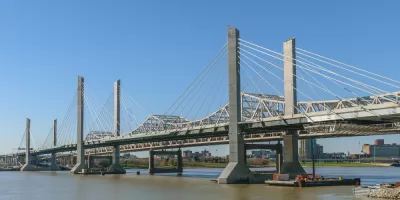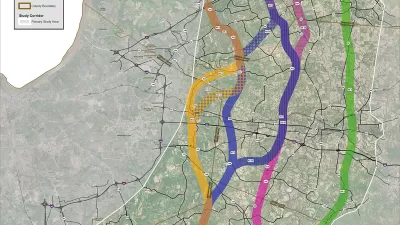Whether you call it the Louisville-Southern Indiana Ohio River Bridges Project, the Downtown Crossing, or the new Spaghetti Junction—call it done.

"With the opening of the East End bridge on Sunday and the official start of tolling set for Friday, Dec. 30, construction of the $2.3 billion Louisville-Southern Indiana Ohio River Bridges Project has pretty much concluded," according to an article by Michael Finley.
"To recap, the bridges project had two major components in the downtown crossing, which included reconfiguring Spaghetti Junction, and the East End crossing, which includes the East End bridge and new roads and tunnels to connect to the bridge," explains Finley. Finley's article provides a retrospective of the project's long construction process.
The Downtown Crossing portion of the project wrapped up construction in November, as reported by Sheldon S. Shafer in a separate article for the Courier-Journal. Earlier this month, the Courier-Journal also commemorated the project by posting aerial images of the completed Spaghetti Junction. Walsh Construction, lead contractor on the project, working with the states of Indiana and Kentucky, also posted a celebratory blog post announcing the end of construction back in November. That project lists the goals and priorities for the project, from the obvious pro-construction perspective of the development team.
For a much more critical take on the pro-highway politics that approved and funded the project, revisit a post by New York Times architecture Michael Kimmelman, who visited the city in 2012.
FULL STORY: From start to finish: One last look at the Downtown Crossing construction

Maui's Vacation Rental Debate Turns Ugly
Verbal attacks, misinformation campaigns and fistfights plague a high-stakes debate to convert thousands of vacation rentals into long-term housing.

Planetizen Federal Action Tracker
A weekly monitor of how Trump’s orders and actions are impacting planners and planning in America.

In Urban Planning, AI Prompting Could be the New Design Thinking
Creativity has long been key to great urban design. What if we see AI as our new creative partner?

King County Supportive Housing Program Offers Hope for Unhoused Residents
The county is taking a ‘Housing First’ approach that prioritizes getting people into housing, then offering wraparound supportive services.

Researchers Use AI to Get Clearer Picture of US Housing
Analysts are using artificial intelligence to supercharge their research by allowing them to comb through data faster. Though these AI tools can be error prone, they save time and housing researchers are optimistic about the future.

Making Shared Micromobility More Inclusive
Cities and shared mobility system operators can do more to include people with disabilities in planning and operations, per a new report.
Urban Design for Planners 1: Software Tools
This six-course series explores essential urban design concepts using open source software and equips planners with the tools they need to participate fully in the urban design process.
Planning for Universal Design
Learn the tools for implementing Universal Design in planning regulations.
planning NEXT
Appalachian Highlands Housing Partners
Mpact (founded as Rail~Volution)
City of Camden Redevelopment Agency
City of Astoria
City of Portland
City of Laramie




























